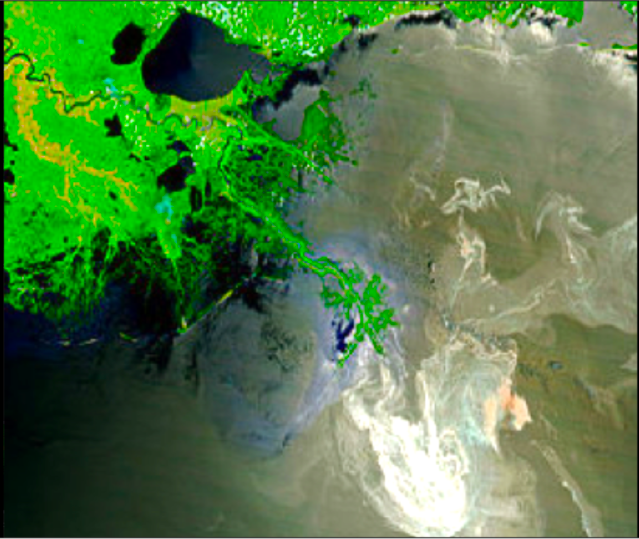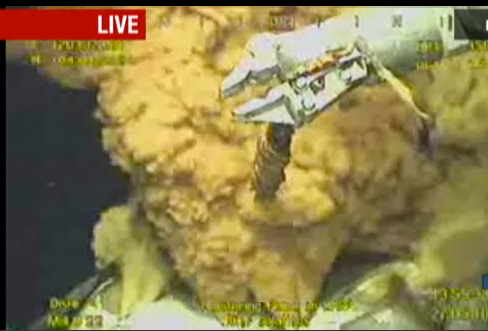







BP has spent an unprecedented amount of money on PR to spin this disaster - they told the public initially that the spill (which should have never occurred in the first place, if safety regulations were followed), was on an order of a magnitude below what has actually spilled into the Gulf (they tried to spin that the well was expelling a mere - but still significant amount of 5,000 barrels of oil per day - when we have since learned that the damage was 10 or more times greater).
The dispersants were yet another attempt to cover-up the damage, and in addition to keeping much of the oil below the surface (out of sight, out of mind), has created a largely invisible toxic stew which may haunt the Gulf Region, and far beyond, for decades...
Quote:
BP is using chemical dispersants in large volumes in the Gulf of Mexico but is this worse than the oil spill?
Chemicals such as oil dispersants only allow the oil to sink to the bottom of the ocean, they do not dissolve the oil.
In addition these chemical dispersants are still toxic to humans, wildlife and fish.
The spill response has been a failure and the oil dispersants decision was made without thought of the pollution these chemicals cause with the oil mixture and the intended use is actually hiding the oil spill problem, not resolving the damage of the oil leak.
What are Chemical Dispersants
The chemical dispersants are made up of two compounds which are a solvent and a surfactant. The dispersants are sprayed on to an oil slick where the solvent carries a sufactant into the oil.
However, it is well known that dispersants have a very small effect on floating oil and can stop being effective as the area of the oil spill requires a greater amount of these chemical dispersants with little success in cleaning the oil out of the water.
The oil becomes a glob and sinks to the bottom of the ocean where it still endangers sea beds of shrimp and other sea animals. In essence, it creates a toxic mess and the results are less than desired.
The Type 1 dispersant is a hydrocarbon solvent sprayed onto the oil at the surface of the water in the Gulf. Another type 3 dispersant is made up of alcohol and glycol in a higher concentration and both types require mixing with the oil after application.
Applications of Dispersants
The method of applying dispersants can be executed by boats that spray the chemicals equipped with pumps. Aerial spraying from planes or helicopters is also used, and shoreline application used to remove the oil on rocks, sea walls, and structures.
The environmental impact of BP Oil’s dispersants will not remove the oil.
it will sink it to the bottom where out of sight it is out of mind. In shallow waters, near the shoreline, higher concentration of the chemicals will stay for longer periods of time
Many ecologists do not agree with using great amounts of these chemicals due to the damage to the wild life, sea birds, fish, oysters, and the spawning cycle which affects the fishing industry in four states.
This affects dophins, pelicans, herons, and other wildlife that inhabit the Gulf. The toxicity level of the Gulf now after the oil spill on April 20, 2010 will certainly be damaged for a lifetime.
BP received approval for this chemical attack on the oil spill from the US government agency the EPA (Environmental Protection Agency) and it was the wrong decision.
However desperate this mess has become, adding more chemicals to the toxic mess will increase the negative impact on the eco-system of the Gulf of Mexico.
The 6,000 square miles of open waters in the Gulf are affected by the explosion and oil leak is still threatening the US economy of Louisiana, Alabama, Texas and Florida. The oil slick is a threat in itself and what is worse is the oil that is not visible, and this is the tip of the iceberg. The total amount of oil spilling could reach 50 million gallons, not including the toxic plume, and the government has not initiated an adequate sampling of how much oil is in the Gulf today. We know BP grossly underestimated the spill amount, probably in an effort to minimize what it will have to pay as a result of this disaster.
Millions of organisms have already died as a result of the spill, including plankton that fish eat, and this will surely result in the death of fish in the Gulf with a lifetime impact.
The authorities were not prepared, and BP and other oil companies were not prepared, to deal with what residents say is basically negligence, and the duty of care was not a priority. BP should put more response into tackling the oil on the surface, and the US government must rethink the impact of oil drilling offshore to its coastline, as the thirst for oil drives more drilling.
If the US government wants to use energy resources intelligently, offshore drilling must end. We now know that he 5,000 barrels of oil leaking per day was not correctly reported by BP - it could be as much as 84,000 barrels a day.
|
I really don't understand what part of this disaster you do not understand, in order to make a post suggesting that it is not such a big deal (since the total impact is decades away from being fully understood).
Seriously, you think the water is so fine there now, please go take a dip, and take Tony Hayward et al, along with you (as if they would risk their big salaries for such a foolhardy experiment)...


ADG